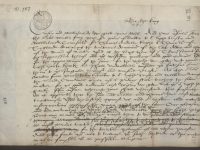A 16th century draft letter demonstrating King Henry VIII’s infamous temper goes on display at Norton Priory from the 5th May.
The correspondence is believed to have been written under dictation from Henry to a secretary. It responded to the news that the canons and local people had stopped his men from closing the Abbey during the Dissolution of the Monasteries in 1536.
Evidently enraged, the King first demands that the Abbot of Norton Abbey be hung drawn and quartered with the body parts displayed around the country. Intriguingly, this has been crossed out and replaced simply with, ‘hung’. Why Henry changed his mind remains a mystery, although research into this and other letters provides a number of possibilities.
Sean Cunningham, Head of Medieval at The National Archives, said: ‘As a king with a reputation for delegation of the routine business of state, this draft signet warrant shows that Henry VIII did, in fact, take a very close interest in events that threatened his power and undermined his sovereignty. We can almost hear his outrage as he decides on the most effective response to the news of events at Norton Abbey. Although ministers like Wolsey and Cromwell were famous for doing most of the bureaucratic moving-and-shaking on Henry’s behalf, the king was educated and intelligent enough to know when and how to bend the system to his will when necessary’.
Dr Andrew Abram from Manchester Metropolitan University said, ‘It is possible that the High Sheriff of Cheshire, Piers Dutton who reported the resistance at Norton was deliberately exaggerating the situation and provoking the King to further his own political goals.’
Dr Mel Evans from the University of Leicester said, ‘The closure of the monasteries was a time of significant political and religious upheaval, and London struggled to keep pace with regional developments. Local magnates, like Lord Brereton, and others with access to the King’s ear, may have helped to persuade Henry to order a (relatively) more benevolent punishment – although this would be small comfort to the Abbot’.
By the 1530s monasteries were seen as corrupt and out of touch with the common people of England and Wales. It was also a time of increasing tensions between the Catholic Pope in Rome and King Henry VIII. In 1531 Henry severed England, Wales and Ireland from the authority of the Roman Catholic Church. His next step was to disband the monasteries. He did this partly to reform the Church but also to strip the monasteries of their fabulous wealth.
The letter will be on loan from The National Archives until the end of August. It will be accompanied by a stunning 16th century silver-gilt reliquary from the Victoria and Albert Museum that is demonstrative of the wealth of the monasteries at that period. The objects illustrate the tumultuous story of the Dissolution of the Monasteries.
The draft correspondence is one of a number of surviving letters that passed between Henry, Thomas Cromwell, his chief advisor during the period of the Dissolution and lords such as Piers Dutton in the North West. The full story detailing all of the letters and their transcripts can be found at the website, https://www.livingletters.co.uk/, supported by the Arts and Humanities Research Council.
Frank Hargrave, Director of Norton Priory Museum & Gardens said, ‘We are enormously grateful to The National Archives and Victoria and Albert Museum for the loan of the draft letter and stunning reliquary. Their loan programmes provide a fantastic vehicle for the display of nationally important artefacts to regional audiences.’







